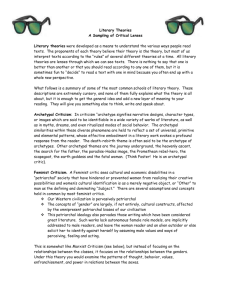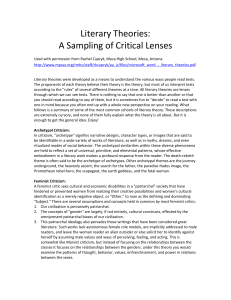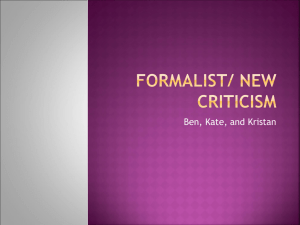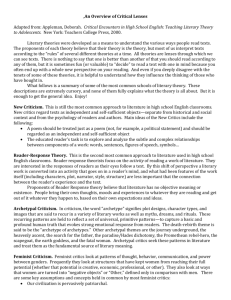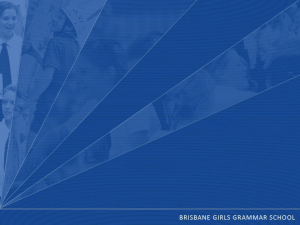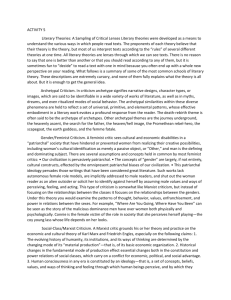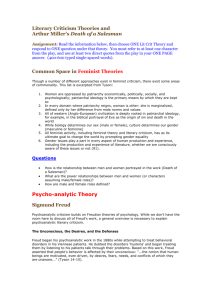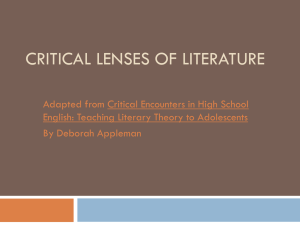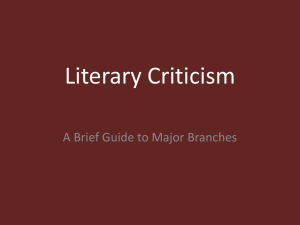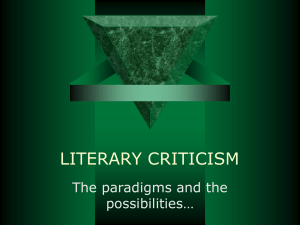Literary Theories
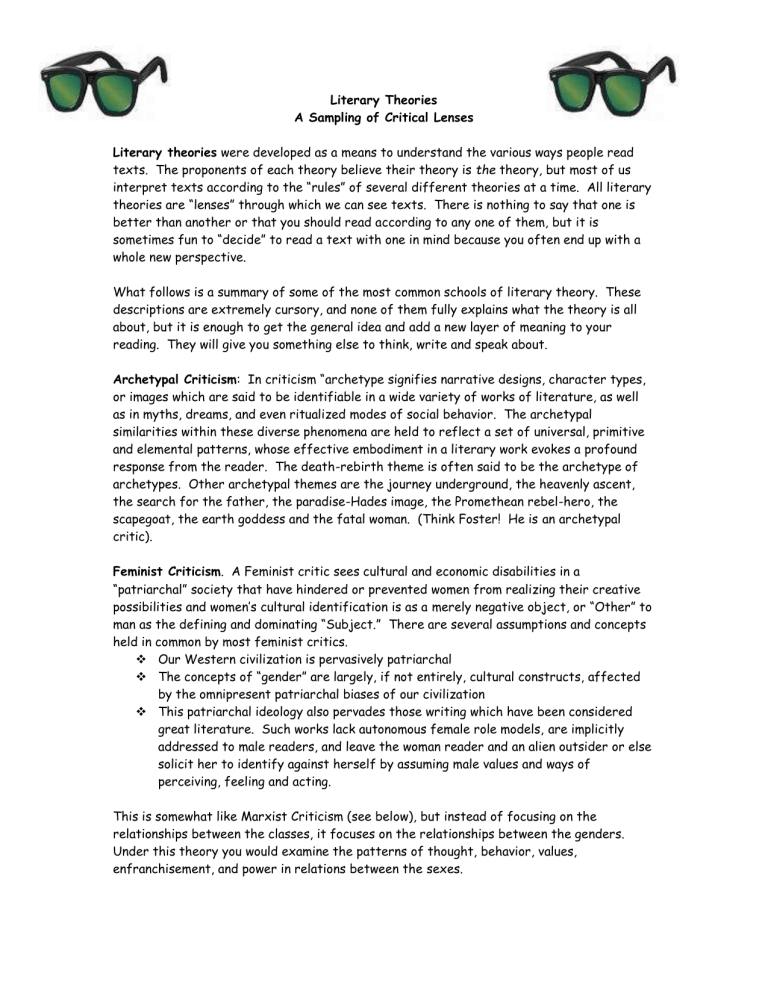
Literary Theories
A Sampling of Critical Lenses
Literary theories were developed as a means to understand the various ways people read texts. The proponents of each theory believe their theory is the theory, but most of us interpret texts according to the “rules” of several different theories at a time. All literary theories are “lenses” through which we can see texts. There is nothing to say that one is better than another or that you should read according to any one of them, but it is sometimes fun to “decide” to read a text with one in mind because you often end up with a whole new perspective.
What follows is a summary of some of the most common schools of literary theory. These descriptions are extremely cursory, and none of them fully explains what the theory is all about, but it is enough to get the general idea and add a new layer of meaning to your reading. They will give you something else to think, write and speak about.
Archetypal Criticism: In criticism “archetype signifies narrative designs, character types, or images which are said to be identifiable in a wide variety of works of literature, as well as in myths, dreams, and even ritualized modes of social behavior. The archetypal similarities within these diverse phenomena are held to reflect a set of universal, primitive and elemental patterns, whose effective embodiment in a literary work evokes a profound response from the reader. The death-rebirth theme is often said to be the archetype of archetypes. Other archetypal themes are the journey underground, the heavenly ascent, the search for the father, the paradise-Hades image, the Promethean rebel-hero, the scapegoat, the earth goddess and the fatal woman. (Think Foster! He is an archetypal critic).
Feminist Criticism. A Feminist critic sees cultural and economic disabilities in a
“patriarchal” society that have hindered or prevented women from realizing their creative possibilities and women’s cultural identification is as a merely negative object, or “Other” to man as the defining and dominating “Subject.” There are several assumptions and concepts held in common by most feminist critics.
Our Western civilization is pervasively patriarchal
The concepts of “gender” are largely, if not entirely, cultural constructs, affected by the omnipresent patriarchal biases of our civilization
This patriarchal ideology also pervades those writing which have been considered great literature. Such works lack autonomous female role models, are implicitly addressed to male readers, and leave the woman reader and an alien outsider or else solicit her to identify against herself by assuming male values and ways of perceiving, feeling and acting.
This is somewhat like Marxist Criticism (see below), but instead of focusing on the relationships between the classes, it focuses on the relationships between the genders.
Under this theory you would examine the patterns of thought, behavior, values, enfranchisement, and power in relations between the sexes.
Marxist Criticism. A Marxist critic grounds his/her theory and practice on he economic and cultural theory of Karl Marx and Friedrich Engles, especially on the following claims:
The evolving history of humanity, its institutions and its ways of thinking are determined by the changing mode of its “material production”—that is, of its basic economic organization.
Historical changes in the fundamental mode of production effect essential changes both in the constitution and power relations of social classes, which carry on a conflict for economic, political, and social advantage.
Human consciousness in any era is constituted by an ideology—that is a set of concepts, beliefs, values, and ways of thinking and feeling through which human beings perceive, and by which they explain what they take to be reality. A Marxist critic typically undertakes to explain the literature in any era by revealing the economic, class, and ideological determinates of the way an author writes, and to examine the relation of the text to the social reality of that time and place.
This school of critical theory focuses on power and money in works of literature. Who has the power and money? Who does not? What happens as a result? Think Gatsby.
New Criticism/Formalistic Approach. This school of criticism is directed against the prevailing concern of critics with the lives and psychology of authors, with social background and with literary history. There are several points of view and procedures that are held in common by most New Critics. (This is what IB and I expect you to do!)
A poem should be treated as primarily poetry and should be regarded as an independent and self-sufficient object.
The distinctive procedure of the New Critic is explication, or close reading: the detailed and subtle analysis of the complex interrelation and ambiguities of the components within a work.
The principals of New Criticism are basically verbal. That is, literature is conceived to be a special kind of language whose attributes are defined by systematic opposition to the language of science and of practical and logical discourse. The key components of this criticism deal with the meanings and interaction of words, figures of speech, and symbols. Tension, irony and paradox should also be considered.
The distinction between literary genres is not essential.
Psychological and Psychoanalytic Criticism. Psychological criticism deals with a work of literature as an expression, in fictional form, of the personality, state of mind, feelings and desires of the author. The assumption of psychoanalytic critics is that a work of literature is correlated with its author’s mental traits:
Reference to the author’s personality is used to explain and interpret a literary work.
Reference to literary works is made in order to establish, biographically, the personality of the author.
The mode of reading a literary work itself is a way of experiencing the distinctive subjectivity or consciousness of its author.
Psychological Criticism may also concern itself with applying various psychological theories to characters which can be tricky. The most common of these applications is Freud’s theories of the unconscious and his ideas about the id, ego and superego.
The id is the resevoir of libido, the source of all psychic energy. It functions to fulfill the primordial life principle, which Freud considers to be nthe pleasure
principle. Freud explains this “obscure inaccessible part of our personality as a chaos, a cauldron of seething excitement with no organization and no unified will, only an impulsion to obtain satisfaction for the instinctual needs, in accordance with the pleasure principle.” It is the source of all agressions and desires.
The ego is the regulating agency of the individual. As Freud says, “in popular language, we may say that the ego stands for reason and circumspection, while the id stands for untamed passions.” The ego is governed by the reality principle.
The superego is the other regulating agent. Largely unconscious, the superego is the moral censoring agency, the repository of conscience and pride. It is, as Freud says the “representative of all moral restrictions, the advocate of the impulse toward perfection, in short it is as much as we we hyave been able to apprehend psychlogically of what people call the higher things in human life.” Acting either directly or through the ego, the superego serves to repress or inhibit the drives of theid, to block off and thrust back into the unconscious those impulses toward pleasure that society regards as unacceptable, such as overt aggression, sexual passions, and the Oedipal instinct. An overactive superego creates an unconscious sense of guilt…or a guilt complex. The supergo is dominated by the morality
principle.
